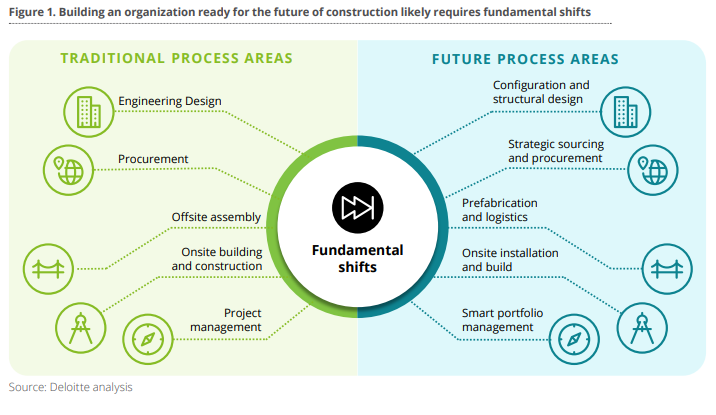5 Ways Collaborative Construction is a Competitive Advantage

According to a recent Deloitte survey, engineering and construction (E&C) executives are investing heavily in technology. Nearly 40% of their operating budgets. The push is to move away from a segmented industry and to create more collaborative construction ecosystems.
But what does this mean for you and your operation, now and in the future?
Here are 5 ways collaborative construction gives you an industry advantage.
Collaboration and the Network Effect in Construction
The swift global response to the coronavirus pandemic of 2019 taught us what we can accomplish when we work together towards a common goal.
Future-ready E&C firms are capitalizing on the network effect. They’re using technology to collaborate with owners, developers, and design professionals early in the pre-construction phase.
Through networked collaboration, pre-construction teams are value-engineering their projects. And as a result, high-value assets are built on time, and on budget, with lower overall life-cycle cost.

The many benefits of the collaborative construction process include:
- Improved communication, coordination, and cooperation across disciplines
- Reduced time to market from project inception to completion
- Fewer mid-project design changes and scope of work variances
- Efficiently constructed projects that create less waste, and lower ecological impacts, while maintaining higher lifetime asset value
Collaborative construction provides end-to-end project transparency too. By keeping all the project stakeholders informed of the progress, and involved in every critical decision.
Procurement and Resource Management
Sourcing and securing materials has become a strategic initiative for many firms. The rising cost of supplies and lack of their availability make resource management a major priority for every project.
Through collaboration, construction firms are expanding their resources while maintaining low overhead costs through lean operating principles.
Collaborative construction management software enables team leaders to pull from a centralized pool of resources. Managers can then intelligently allocate resources and plan for future requirements. This saves time, money, and valuable raw materials across the firm’s entire portfolio.
Safety and Quality Control via Remote Jobsite Management
In the early stages of the pandemic, protecting the workforce was critical. With digital health screening, strategic workforce management, virtual meetings and inspections, the construction industry stayed in compliance with CDC recommendations.
These remote practices endure–with more integrative technology on the way.
- Drone videos and live chat with smart-phones continue to provide instant job-site access to managers, supervisors and inspectors. These practices are also becoming commonplace in the industry.
- Sensors and next-generation construction wearables are gaining popularity too. These devices protect and augment worker capabilities and monitor the vital signs and location of everyone on site.
- Mobile apps and collaborative construction software allow managers and supervisors to create plan-centric workflows. By linking plan sheets, images and documents to scheduled activities in the field, managers can sequence activities for maximum effect. Field personnel can respond with real-time feedback, shortening decision times, accelerating progress and preventing delays.
Collaborative Construction and Dynamic Scheduling
Traditional project scheduling cannot meet the needs of modern construction operations. The industry’s poor performance record shows the need for radical change in this area.
The dynamic scheduling model employs collaborative scheduling software to track and report on multiple objectives in real time. The software pulls and analyzes data to push progress reports. The algorithm also forecasts future schedule requirements, empowering managers to make sound decisions.
Dynamic schedules are collaborative resources, connecting the entire project team to a unified master schedule. This strategy builds efficiencies in the following areas:
- Contractors take an active role in schedule management. They can break down their field work, assign internal tasks, and track resources against their budgets
- Work Breakdown Structures, targets and milestones are available by mobile app or desktop for project-wide visibility and planning. Schedule progress and performance reports are updated in real time based on work completed and tasks remaining.
- ERP and financial system integrations streamline payment requests and fulfillment. The predictive software projects financial performance against work completed and work remaining for proactive financial project management.
Collaborative Construction with BIM and Digital Twinning
Building Information Modeling (BIM) provides a 3-dimensional visual and quantitative model of the designed asset prior to construction. This empowers architects, engineers and contractors (AEC) to collaborate on feasibility, constructability, project planning and sequencing.
This makes problem-solving easier and more cost-effective. Project financial risk is mitgated too. Errors are reduced, and ensures both the schedule and the budget are adequate before the build begins.
A Digital Twin picks up where BIM leaves off. A digital twin provides a comprehensive assessment of how the building is responding to occupant demands in real time.
Digital Twins relay critical information about the condition and operating capacities of the building’s systems and subsystems. These reports relay service requirements and predict asset longevity throughout the building’s lifecycle.
Collaborative Construction is the Future
Collaborative technology is the future of construction. By using this technology, construction projects can be completed more efficiently and cost-effectively. And as a result, construction companies and their clients can build safe, ecologically conscious environments. This saves time, money and valuable resources.
The future of the construction industry relies on effective use of these collaborative technologies.
Get a personalized demonstration of the Linarc collaborative construction system and step into the future with Linarc.




